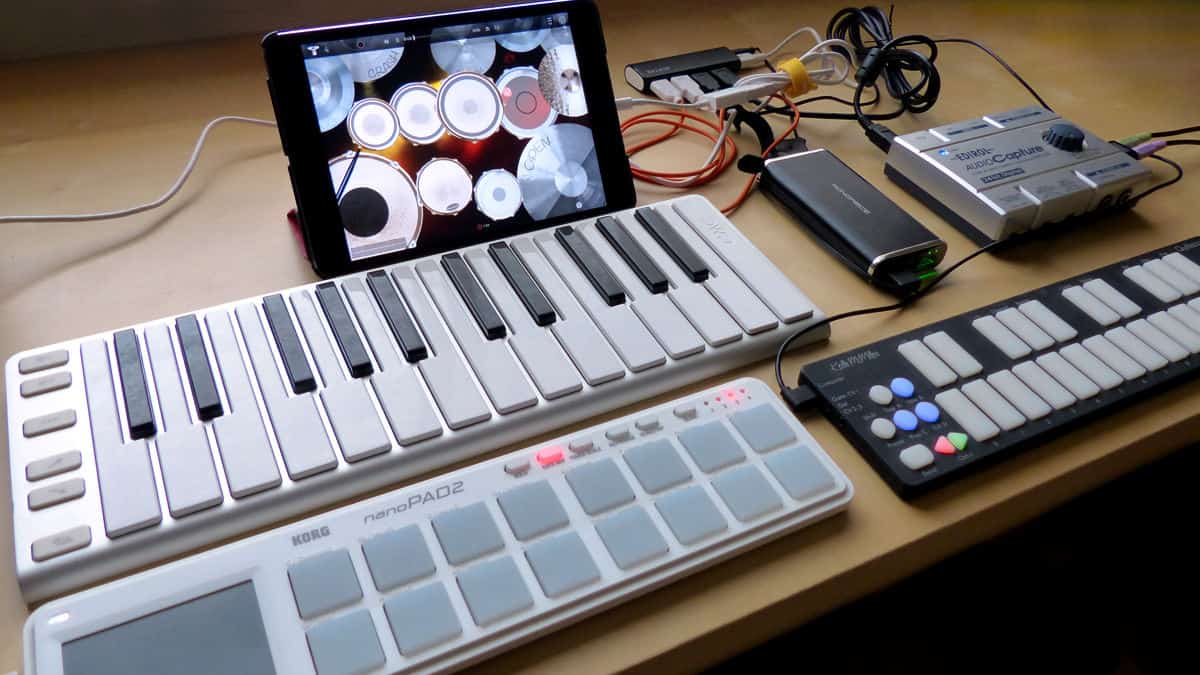Columns
Bat Utility Belt: Hub Will Set You Free

Connect masses of audio gear to your iPhone or iPad with a powered USB hub.
Steve Jobs famously introduced the iPod as “a thousand songs in your pocket.” Today, the iPhone can put a thousand synths in that same space. But like all software synths, iOS music apps really come alive when you add a hardware MIDI controller. In the photo above, I used an Apple Lightning-to-USB adapter and a powered USB hub to connect three MIDI controllers and an audio interface to my iPad Mini. The adapter and hub together cost less than $40, making them another great fit for the Bat Utility Belt series.
Besides merging the controllers, the hub—a basic Belkin four-port I picked up years ago—also supplies extra power by way of its 5V input jack. (The original Apple USB adapter offers only a trickle, leading to the dreaded “attached accessory uses too much power” error. My Belkin came with a wall-wart power supply. However, I discovered I could also inject power with a USB battery pack, creating a totally portable setup.
The hub’s fourth USB port hosts an ancient Edirol UA-20 audio interface, adding stereo I/O and a dedicated headphone jack. For more power and ports, Jason Donnelly (iPad Loops) recommends the Anker 7-port hub, which comes with a 12V power supply.
Speaking of Audio…
Figure 1 shows a simpler application for a powered USB hub: powering a USB audio interface. I’d been set to buy a plug-in Lightning mic for my iPad when I realized my Zoom H2n recorder would work as both a mic and an audio interface over USB. The H2n draws too much current to connect directly to the Apple USB adapter. It worked perfectly through the powered USB hub, though. (Although you can aggregate multiple MIDI peripherals with a USB hub, as of this writing, iOS supports only one USB audio device at a time.)

Hub a Synth Today
So far, we’ve talked about MIDI input. But you can also use a powered USB hub to connect hardware synths to an iOS device. That lets you take advantage of sequencers, arpeggiators, and other MIDI apps. Figure 2 shows the Gakken Pocket Miku, a strange little speech synthesizer that sings in Japanese. Typically, you play it by tapping and sliding the stylus on its ribbon keyboard. Miku also has a micro USB jack for power and MIDI. It’s not a USB host, so you can’t connect a controller directly. By inserting an iPad or iPhone in the chain, however, you can use the iOS device as a host and router.
To route the MIDI data, I used the Midi Tool Box app, setting the input to the Xkey, the output to “NSX-39,” and MIDI Thru to “Enabled.” That let me play Miku from the Xkey’s full-size keyboard. NSX-39 refers to the Yahama NSX-1 eVocaloid chip that gives Miku its voice. It’s quite deep, as you can read in Paul Drongowski’s Pocket Miku review.
To connect iOS devices to synths that have traditional 5-pin MIDI jacks, I use one of those no-name cables with a USB plug at one end, two MIDI plugs at the other, and a mysterious lump in the middle.
Dongle Fever
Funny story: Several years ago, I was leading an electronic jam at an audio conference when a friendly guy from Apple strolled up and asked if he could plug in. Ironically, his new iPhone was the first model that lacked a 3.5mm audio jack. The next year, I came prepared with an adapter that improves on Apple’s Lightning-to-USB dongle by adding jacks for audio and charging. Figure 3 shows it in action, with a small speaker connected to the 3.5mm audio output and a MIDI knob box connected to the USB jack. Many modern controllers I’ve tried draw so little current that they don’t need a powered USB hub in the middle. The makes for a very compact setup if you want just one input device.
And if you want more? Just keep on hubbing. Figure 4 shows a setup I created for a magazine shootout: five keyboards playing one iPad. With each set to play the same soft synth, it was an easy way to compare the feel of each keyboard. In the end, I kept three of them, “synthesizing” my own perfect instrument.
What’s in Your Utility Belt?
The Bat Utility Belt series covers surprisingly useful synth gadgets that cost less than $100. Got a tip? Post it on Facebook, Instagram, or Twitter and tag your nomination #BatUtilityBelt. You can also reach me through Batmosphere.com. If I feature your submission in an upcoming column, you’ll win a free subscription to Synth and Software. Oh, wait—that’s free already. Hubba hubba!
Websites: Anker 7-port USB hub | Masaya Lightning-to-USB/headphone/charging adapter | Gakken Pocket Miku (As an Amazon Associate, the author earns from qualifying purchases.)
Price: $16.99 and up


















